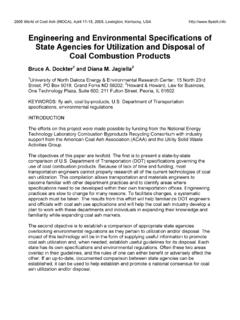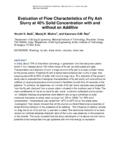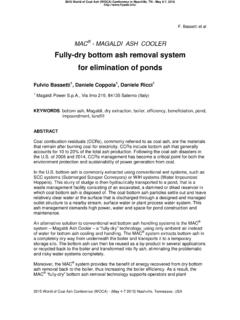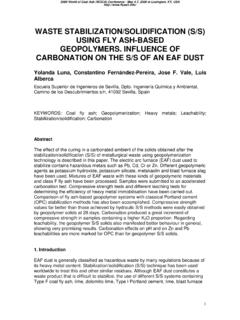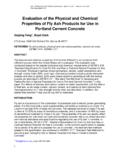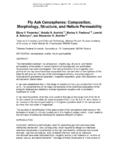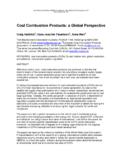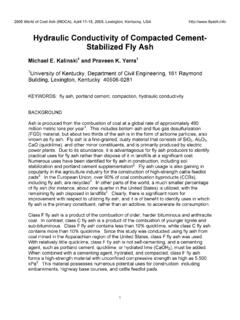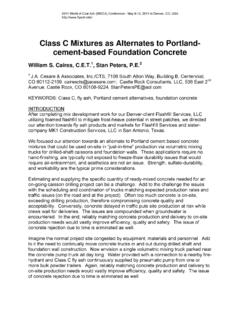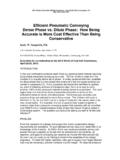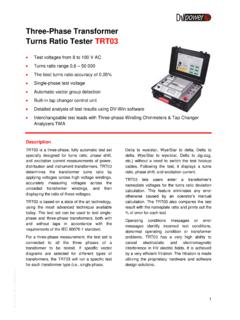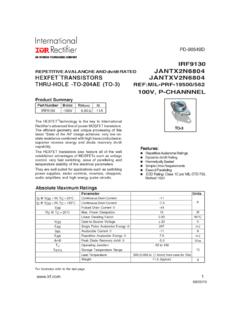Transcription of Reliability of Loss on Ignition (LOI) Test for …
1 Reliability of loss on Ignition (LOI) Test for Determining the Unburned Carbon Content in Fly Ash Mina Mohebbi, Farshad Rajabipour, Barry E. Scheetz The Pennsylvania State University, Department of Civil Engineering, 231M Sackett Building, University Park, PA 16802-1408 CONFERENCE: 2015 World of Coal Ash ( ) KEYWORDS: fly ash, unburned carbon, loss on Ignition , thermogravimetric analysis, two atmospheres ABSTRACT Unburned carbon in fly ash can significantly affect its beneficial applications in concrete mixtures. The water requirement and rheological properties of concrete are influenced as high carbon content ashes generally require greater water/binder ratio to show good workability.
2 The dosage of air entraining agents (AEA) in concretes containing fly ash is also affected by carbon content. loss on Ignition (LOI) test is a generally accepted method for estimating the unburned carbon content of fly ash. However, it has been observed that LOI results may overestimate the amount of organic carbon as the Ignition mass loss is not only due to burning of organic carbon, but also due to other possible reactions such as calcination of inorganic carbonates, desorption of physically and chemically bound water ( , dehydration of portlandite), and oxidation of sulfur and iron minerals. In this study, a modified thermogravimetric analysis (TGA) is performed under two distinct atmospheres; helium, a non-oxidizing atmosphere to measure Ignition loss due to carbonates and bound water, and air as an oxidizing atmosphere to measure the true organic carbon content.
3 This method is applied to a class F fly ash with low LOI. X-ray diffraction (XRD) and bulk chemical analysis were also used to better assess changes in composition and mineralogy of ashes during the Ignition process. The two step TGA method could successfully separate carbon oxidation from other possible reactions recognized using mass spectrometry and thermal analyses techniques. INTRODUCTION Combustion of coal to generate electricity produces approximately 130 million tons of coal combustion products (CCPs) each year in the United These residuals include fly ash, bottom ash, boiler slag, and flue gas desulfurization (FGD) material. Power plant facilities dispose this large volume of CCPs by placing them in landfills and surface impoundments or alternatively, find beneficial uses and markets for these materials.
4 CCPs can be beneficially used as supplementary cementing materials in concrete products, structural fills, soil stabilization, agricultural applications, waste 2015 World of Coal Ash (WOCA) Conference in Nasvhille, TN - May 5-7, 2015 , and mining applications. According to American coal ash association survey report 2012,2 among different coal combustion products, fly ash has the highest proportion, and many current studies are working on how to use fly ash as a substitute for conventional cementitious binders in concrete. The presence of unburned (organic) carbon in fly ashes has several important effects on their concrete applications. The color of concrete and mortar including fly ashes may change to black or dark The water requirement of fly ash-cement pastes and the rheological properties of concretes are also affected because the water to cement + fly ash ratio to gain a paste with normal consistency is greater for fly ashes with high carbon Moreover, using fly ash in concrete has been found to affect the required dosage of air entraining admixtures (AEAs)
5 To entrain the proper amount of air in the concrete Instead of stabilizing the air water/cement interface, the AEAs are strongly adsorbed by some fractions of the fly ash, resulting in a reduced amount of AEAs stabilizing the entrained The unburned carbon appears to be responsible for the adsorption of A large portion of the carbon surface is non-polar compared with the polar surface of the inorganic particles. This provides active adsorption sites for the hydrophobic part of the surfactants, thus the carbon competes with the air/water interface. 7 loss on Ignition (LOI) has long served as a conventionally used method to measure unburned carbon in fly ash.
6 Many standard specifications limit LOI values assuming this parameter provides a good estimation of combustible carbon content. ASTM C618 specifies maximum LOI of 6 wt% for class C and F coal ash while being used in However, recent studies have shown that this method overestimates unburned carbon due to some other reactions besides organic carbon These reactions can include dehydration of lime and release of structural water from residual clays, decomposition of carbonates, and oxidation of sulfides and iron minerals upon heating. Consequently, LOI is replaced with more accurate methods such as thermogravimetric analysis, which can provide details on weight changes with temperature and time.
7 Thermogravimetric analysis (TGA) can be carried out in different atmospheres. Coupled to mass spectrometry (MS), thermal analysis provides information on the gases released from the powder at different temperatures. However, using only oxidizing atmosphere ( air) resulted in overlapping emissions in the same temperatures, from which it was difficult to separately measure the weight losses due to carbon oxidation. In this study, a two-atmosphere thermogravimetric analysis coupled to mass spectrometry is suggested for measuring organic carbon in a class F fly ash, and the results have been interpreted using bulk chemical analysis of fly ash, and X-ray diffraction method.
8 MATERIALS AND METHODS The as-received fly ash used in this study is originated from First Energy corporation power plant located in Pennsylvania, USA. It is a class F pulverized coal ash according to ASTM C618 classification. The ash was characterized by moisture content10, particle size distribution (laser diffraction), density (He pycnometer), surface area (ASAP 2020 Automated Surface Area and Porosimetry System, using N2 gas) and bulk chemical analysis. The samples for these analyses were picked using cone and quarter method to gain a representative of the bulk. X-ray Diffraction analysis of the crystallographic phases was performed on PANalytical Empryean - powder diffractometer with para-focusing optics using CuK radiation.
9 The detector was employed over the angular range of 7-70 (2 ) with a step size of (2 ) and a counting time of 197 s step-1. Data evaluation was performed using the powder XRD analysis software MDI-Jade 2010. Before running XRD analysis, fly ash sample was crushed using high energy ball mill in order to decrease the particle size to <10 m. LOI Methodology ASTM D7348 procedure was used to run the LOI test in this method was performed with g of fly ash as measured with an analytical balance. In the first step, the sample was placed in a clean crucible and heated at 110 C in an oven for 1 hour. Then, the sample was removed from the oven, and placed in a desiccator to cool for 60 min before being reweighted.
10 The weight loss in this step was recorded as moisture content of fly ash. In the second step, dried fly ash was placed in a furnace with an air atmosphere and heated in a stepped schedule for 2 hr to reach 950 C. The fired sample was cooled down to room temperature in a desiccator, and then weighted. The weight loss associated with firing the sample is known as the loss on Ignition (LOI). Bulk Chemical Analysis was performed on digested fly ash sample using lithium metaborate fusion technique. By this method, solid samples were digested to liquid, and then the elemental composition of solution was analyzed by Perkin-Elmer Optima 5300DV ICP-AES. TGA-MS: a modified thermogravimetric analysis coupled to mass spectrometry system was used to determine the combustible carbon content in class F fly ash.
